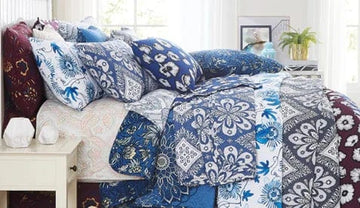How to Give Your Bedroom a Proper Mid-Century Look
It’s not surprising that many people want to create a mid-century modern bedroom. Even though the style originated in the 1950s and 1960s, the style still suits the way we live today.
Creating a proper mid-century look isn’t difficult, providing you follow a few basic rules. The following are what differentiate mid-century modern from other bedroom design styles.
Simple & Functional
Open space is a primary concept in mid-century design and most of us want that feel in our bedroom today, too. Consequently, the bulky, ornate furniture of the past doesn’t suit a mid-century modern bedroom.
Instead, functional, scaled down furniture is a necessity. A simple platform bed, plenty of storage, and portable pieces such as a few chairs that serve several functions are good examples.
This style is all about celebrating new, easy care materials and simple living for people with busy lives. No one wanted to fuss with complicated pillow arrangements or spend hours washing and drying linens.
An easy to launder geometrically embroidered quilt tucked around your mattress, crisp white or coordinating sheets, and just a few pillows strategically set on the bed are all you need to create the focal point of the bedroom.

Clean Lines
The mid-century modern style is uncluttered and understated. There is a strong emphasis on horizontal, clean lines.
For instance, designers looking to create a mid-century look opted for a six drawer low-sitting dresser over a high boy, and low, wide bedside tables over tall spindly ones. They chose simple window coverings and avoided frills, valances, and tie-backs.
Mixed Materials
Mid-century modern celebrated new materials, but also mixed them with traditional ones. It also blended organic and geometric forms.
As an example, you might find curvy furniture or accessories made from bent plywood, fiberglass, or plastic laminates molded into contours in a mid-century design. However, these organic forms contrasted with harder shapes in materials such as plexiglass, glass, steel, aluminum, or brass.
Designers also respected natural materials such as wood, brick, and marble. They never tried to disguise the material, so natural wood was the choice over painted furniture.
Muted Palette
With some exceptions, a mid-century modern color scheme is generally neutral. Walls painted in light colors complemented by subtle neutrals such as cream, gray, brown, or white in bedding and furniture create a timeless look.
However, mid-century modern also allows you to add splashes of bold color if you’re looking for something more dramatic. Bright orange, chartreuse green, purple, blue, and teal were all popular during this era.
Add a signature piece of brightly colored furniture or vibrant bedsheets to offset the neutral palette.
Negative Space
The power of negative space pervades all design, but especially in a mid-century modern bedroom. It’s the breathing space around furniture, artwork, and accessories that allows your eyes to rest and then take in the objects in the room.
The number one rule in a mid-century modern bedroom is no clutter. Create visual harmony and comfort. Choose each piece carefully and don’t overcrowd the room. Less is definitely more in a well-designed mid-century modern bedroom.
If you follow these basic rules, you can create a mid-century modern bedroom that respects the design principles and works with the way you live today.



